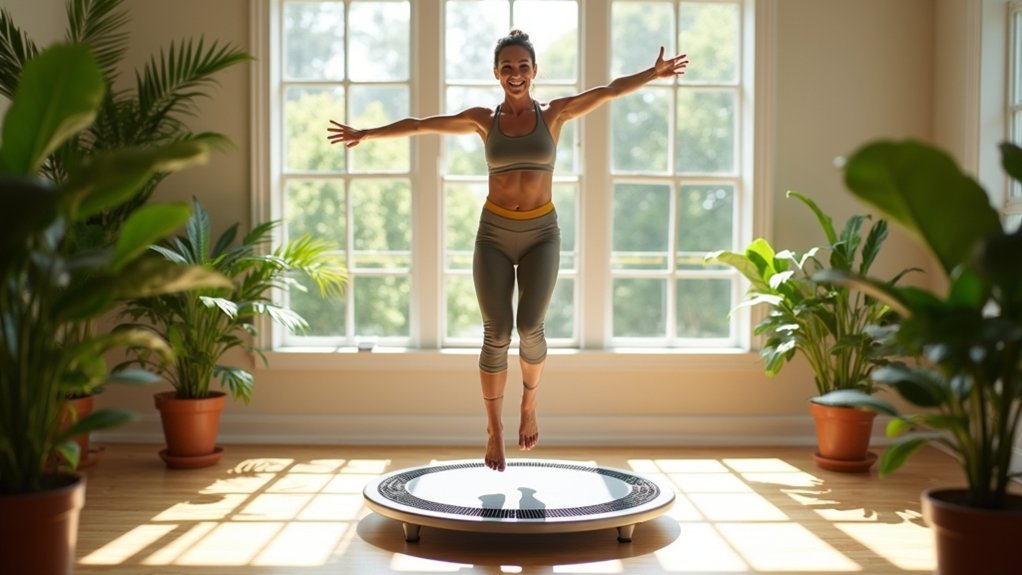To boost your lymphatic system, try these beginner-friendly exercises: gentle rebounding on a mini-trampoline, walking in place, arm circles, shoulder rolls, marching movements, weight-shift jumps, and heel taps. Start with just 5 minutes daily and breathe deeply during each movement. These low-impact exercises stimulate lymphatic circulation while being accessible for all fitness levels. The following guide will show you how to perform each technique for maximum detoxification benefits.
Understanding How Rebounding Benefits Your Lymphatic System

While many exercise routines focus primarily on cardiovascular health or muscle building, rebounding on a mini trampoline offers unique advantages for your lymphatic system. The gentle bouncing motion stimulates lymphatic circulation, effectively promoting lymph fluid movement throughout your body and enhancing detoxification processes.
Unlike high-impact workouts, rebounding provides a low-impact exercise option suitable for beginners. Just 10 minutes of bouncing increases your heart rate while simultaneously supporting immune function. The rhythmic movements activate your body’s natural pump mechanisms, preventing lymphatic stagnation and encouraging proper fluid movement.
What makes rebounding particularly effective is its all-encompassing nature—you’ll improve cardiovascular health and muscle strength while directly addressing lymphatic health. This makes rebounding an efficient option if you’re looking to support overall wellness through gentle yet effective movement.
Gentle Bouncing: The Foundation of Lymphatic Rebounding
Because proper technique forms the cornerstone of effective lymphatic rebounding, gentle bouncing deserves special attention when you’re first starting out. This low-impact exercise stimulates lymphatic circulation without stressing your joints, making it perfect for beginners of all fitness levels.
When you bounce gently on a rebounder, you’re encouraging lymph fluid movement through your body’s lymphatic vessels. This process aids in detoxification by efficiently draining excess interstitial fluid, reducing swelling and improving your energy levels.
Just a few minutes daily provides significant cardiovascular benefits while strengthening muscles and improving balance. You don’t need vigorous jumping to see results—consistent gentle bouncing is enough to enhance immune function and support your body’s natural cleansing processes.
The gentle art of rebounding delivers powerful benefits through the smallest movements, awakening your body’s natural healing systems.
Start with small, controlled bounces and maintain proper posture.
Basic Bounce and Hold for Lymphatic Activation

The Basic Bounce and Hold technique requires proper form where you’ll gently rebound while maintaining a slight knee bend throughout the movement.
You’ll maximize lymphatic benefits by synchronizing your breathing—inhaling as you rise and exhaling as you descend—creating a pumping effect that enhances fluid circulation.
Beyond just moving lymph, this exercise strengthens your core, improves balance, and provides a joint-friendly workout that’s easily adaptable to your fitness level.
Proper Bounce Technique
Mastering proper bounce technique forms the foundation of effective lymphatic exercise on a rebounder.
Stand with feet hip-width apart and allow your knees to flex slightly as you begin the basic bounce. Your feet should leave the rebounder just enough to create gentle movement while maintaining soft landings that protect your joints.
Keep your body relaxed yet engaged, with your core activated for balance and proper posture. Let your arms swing naturally beside you or raise them overhead to enhance the workout.
For ideal lymphatic fluid movement, try holding your bounce for a few seconds at the peak of each jump.
As a beginner, establish a comfortable rhythm first, then gradually increase duration and intensity as your body adapts to this energizing exercise.
Benefits Beyond Movement
While most exercises focus primarily on cardiovascular gains, the Basic Bounce and Hold delivers exceptional benefits for your lymphatic system. This gentle bouncing exercise stimulates lymphatic flow, promoting natural detoxification and reducing fluid retention throughout your body.
| Benefit | Impact | Result |
|---|---|---|
| Enhanced lymphatic drainage | Reduces swelling | Improved comfort |
| Stimulated immune system | Better pathogen response | Increased wellness |
| Activated muscle groups | Improved muscle tone | Greater stability |
| Minimal joint impact | Safe for most beginners | Reduced injury risk |
| Convenient accessibility | Practice anywhere | Consistent routine |
The beauty of this accessible option lies in its simplicity—you’ll improve circulation with minimal effort while supporting your body’s natural cleansing mechanisms. As you practice this movement regularly, you’ll notice reduced swelling and discomfort, particularly if you experience lymphedema symptoms.
Health-Bounce Technique for Lymphatic Circulation
Gentle bouncing on a rebounder offers beginners an effective way to stimulate lymphatic circulation without stressing your joints. This health-bounce technique requires minimal effort but delivers maximum benefits for your lymphatic system.
Just 10 minutes of rhythmic motion on a rebounder can activate your body’s natural detoxification processes. As you bounce, the surrounding muscles contract, efficiently pushing fluid through your lymphatic vessels.
You’ll find this exercise particularly accessible as you can perform it at your own comfortable pace.
When you incorporate health-bounce into your regular routine, you’re not just supporting lymphatic flow—you’re improving your overall cardiovascular health and physical fitness.
It’s a simple yet powerful technique that enhances immune function while providing a gentle, effective workout for beginners.
Simple Arm Movements to Enhance Lymphatic Flow

Arm movements offer an effortless yet powerful way to stimulate your lymphatic system. Simple arm movements like shoulder rolls and arm circles promote circulation and reduce fluid stagnation in your upper body.
Try incorporating backward shoulder rolls to enhance lymph drainage from your neck and shoulders, relieving tension while improving mobility.
Backward shoulder rolls effectively release neck tension while encouraging lymphatic drainage—a simple movement with dual benefits.
You’ll find that pectoral stretches performed in a doorway open your chest, allowing for better lymphatic flow from your arms and upper torso.
Gentle arm swings, whether you’re standing or seated, activate muscles surrounding lymphatic vessels, helping lymph fluid move more efficiently.
For ideal results, practice these movements 10-20 times each, consistently.
You don’t need complex routines to support your lymphatic health—these straightforward exercises contribute greatly to your overall well-being.
Creating Your 5-Minute Beginner Rebounding Routine
Five minutes is all you need to kickstart your lymphatic system with a simple rebounding routine.
Start by walking in place on your mini-trampoline to activate lymphatic flow and improve balance. Next, progress to larger marching movements with arm swings to engage multiple muscle groups and enhance cardiovascular benefits.
Incorporate weight shift jumps, moving side to side to stimulate lymphatic movement while strengthening your balance. Then add gentle jumping jacks with just your feet to promote coordination and prepare your body for more dynamic exercises.
Finish your routine with heel taps as a cool-down exercise. This low-impact movement maintains lymphatic engagement while allowing your body to recover.
This beginner-friendly sequence provides a complete approach to rebounding that’s effective yet accessible for newcomers.
Progressing Safely: When and How to Increase Intensity
As you grow more comfortable with your beginner lymphatic exercises, you’ll want to gradually increase intensity without overwhelming your system.
Watch for signs of overexertion like excessive fatigue, dizziness, or unusual soreness, which signal it’s time to scale back your efforts.
Adding just 5-10 minutes weekly to your routine, incorporating more dynamic movements, or using a heart rate monitor can help you progress safely while maximizing lymphatic benefits.
Monitor Overexertion Signs
While enthusiasm for your new lymphatic exercise routine is commendable, recognizing when you’re pushing too hard is essential for long-term success. Your body provides clear signals when it’s time to dial back intensity or add extra recovery time.
- Watch for excessive fatigue that persists more than 24 hours after exercise.
- Pay attention to unusual shortness of breath that doesn’t improve with rest.
- Monitor persistent muscle soreness that interferes with daily activities.
- Note any dizziness, nausea, or sharp pain during or after your workout.
- Observe changes in sleep patterns or unusual heart rate fluctuations.
Remember to increase exercise intensity gradually—no more than 10% weekly—and use the Borg RPE scale to gauge your exertion level.
When in doubt, consult with a fitness provider who can help adjust your progression plan to match your body’s needs.
Gradual Progression Methods
The journey to improved lymphatic health requires patience and strategic advancement through your exercise program. To safely boost your lymphatic flow, gradually increase your workout intensity by adding 1-2 repetitions weekly or extending each exercise by 1-3 minutes.
| Week | Exercise Adjustment | Monitoring Technique | Deep Breathing Focus |
|---|---|---|---|
| 1-2 | Add 1 repetition | Check for discomfort | 4-count breaths |
| 3-4 | Extend by 1 minute | Assess energy levels | Diaphragmatic focus |
| 5-6 | Add new movements | Note recovery time | Rhythmic patterns |
| 7-8 | Combine exercises | Track overall progress | Full lung expansion |
Always monitor your body’s response to increased intensity. If you experience pain, scale back immediately. Incorporate variety in your movements to engage different muscle groups while maintaining adaptability. Regular progress assessments will guarantee your routine evolves with your improving fitness, creating sustainable lymphatic health benefits.
Frequently Asked Questions
What Is the Best Exercise to Drain the Lymphatic System?
Walking is your best option for lymphatic drainage. It’s gentle yet effective for moving fluids throughout your body. You’ll also benefit from rebounding on a mini-trampoline, which stimulates circulation with minimal joint impact.
How to Jump Start Your Lymphatic System?
You can jump start your lymphatic system by walking daily, practicing deep diaphragmatic breathing, doing shoulder rolls, performing gentle rebounding exercises, and staying hydrated. These activities stimulate lymphatic flow and enhance detoxification effectively.
What Is the Fastest Way to Cleanse Your Lymphatic System?
To quickly cleanse your lymphatic system, combine rebounding or brisk walking with deep diaphragmatic breathing. Stay well-hydrated, perform gentle stretches daily, and eat anti-inflammatory foods like leafy greens and berries. It’s a thorough approach.
Do Squats Help Lymphatic Drainage?
Yes, squats help your lymphatic drainage. When you perform squats, muscle contractions push lymph through your system. They’ll improve circulation, activate your calf muscle pump, and enhance overall lymphatic flow in your lower body.
In Summary
You’ve now discovered seven simple yet effective rebounding exercises to jumpstart your lymphatic system. Remember, consistency matters more than intensity when you’re beginning. Start with just 5 minutes daily and you’ll notice improved energy, reduced swelling, and better immune function. Listen to your body, progress at your own pace, and you’ll be nurturing one of your body’s most important cleansing systems.





Leave a Reply